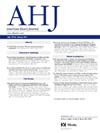PCI报告中嵌入提醒以优化出院糖尿病护理(REMIND-DM):基本原理、设计和基线特征。
IF 3.7
2区 医学
Q1 CARDIAC & CARDIOVASCULAR SYSTEMS
引用次数: 0
摘要
背景:尽管有强有力的临床证据支持钠-葡萄糖共转运蛋白-2 (SGLT2)抑制剂和胰高血糖素样肽-1受体激动剂(GLP-1RA)在高危2型糖尿病(T2DM)及伴发心血管疾病患者中的作用,但它们的处方仍然不够理想。血管造影后的临床遭遇可能是改善高危T2DM患者实施的关键机会。方法:在PCI报告中嵌入提醒以优化出院糖尿病护理(REMIND-DM)是一项实用的、前瞻性的、集群随机的质量改进研究,研究对象是接受血管造影的2型糖尿病患者,并作为质量改进计划运行。在6个月的“基线期”后,REMIND-DM将密歇根心血管协会蓝十字蓝盾(BMC2)质量改进协作项目中的23个参与经皮冠状动脉介入治疗(PCI)的站点(在研究期间护理了7045名患者)随机分为常规护理或质量改进干预,包括与决策支持工具相关的PCI报告模板“提醒”用药资格。研究人员对这些站点进行了为期6个月的“评估期”。主要结局是PCI术后出院符合条件的患者中SGLT2抑制剂或GLP-1RA的新处方。为了检查干预措施的有效性,将采用差异中差设计进行初步分析,检查两组从基线到评估期新的心脏保护治疗处方的变化。结论:REMIND-DM实施试验招募了大量高风险的T2DM患者,并将确定pci术后BMC2内低触点QI干预的有效性,以改善高风险T2DM患者降低风险治疗的及时处方。本文章由计算机程序翻译,如有差异,请以英文原文为准。
Reminders embedded in PCI reports to optimize discharge diabetes mellitus care (REMIND-DM): Rationale, design, and baseline characteristics
Background
Despite the robust clinical evidence base supporting their role for high-risk patients with type 2 diabetes (T2DM) and concomitant cardiovascular disease, prescription of sodium-glucose co-transporter-2 (SGLT2) inhibitors and glucagon-like peptide-1 receptor agonists (GLP-1RA) remains suboptimal. Clinical encounters occurring in the period post angiography may present a key opportunity to improve implementation in high-risk patients with T2DM.
Methods
Reminders EMbedded IN PCI Reports to Optimize Discharge Diabetes Mellitus Care (REMIND-DM) is a pragmatic, prospective, cluster randomized quality improvement study in patients with type 2 diabetes undergoing angiography and was run as a quality improvement initiative. Following a 6 month “baseline period”, REMIND-DM randomized 23 participating percutaneous coronary intervention (PCI) sites (caring for 7,045 patients over the study period) within the Blue Cross Blue Shield of Michigan Cardiovascular Consortium (BMC2) quality improvement collaborative to either usual care or a quality improvement intervention consisting of a templated PCI report “reminder” of medication eligibility linked to a decision support tool. Sites were followed for a 6 month “evaluation period.” The primary outcome is the new prescription of SGLT2 inhibitor or GLP-1RA among eligible patients at discharge after PCI. To examine the effectiveness of the intervention, primary analyses will be conducted using a difference-in-difference design examining changes in new cardioprotective therapy prescription from baseline to the evaluation periods in both arms.
Conclusions
The REMIND-DM implementation trial has enrolled a large, high-risk population of patients with T2DM and will determine the effectiveness of a low touch QI intervention within BMC2 implemented in the post-PCI period to improve timely prescription of risk lowering therapies in high-risk patients with T2DM.
求助全文
通过发布文献求助,成功后即可免费获取论文全文。
去求助
来源期刊

American heart journal
医学-心血管系统
CiteScore
8.20
自引率
2.10%
发文量
214
审稿时长
38 days
期刊介绍:
The American Heart Journal will consider for publication suitable articles on topics pertaining to the broad discipline of cardiovascular disease. Our goal is to provide the reader primary investigation, scholarly review, and opinion concerning the practice of cardiovascular medicine. We especially encourage submission of 3 types of reports that are not frequently seen in cardiovascular journals: negative clinical studies, reports on study designs, and studies involving the organization of medical care. The Journal does not accept individual case reports or original articles involving bench laboratory or animal research.
 求助内容:
求助内容: 应助结果提醒方式:
应助结果提醒方式:


